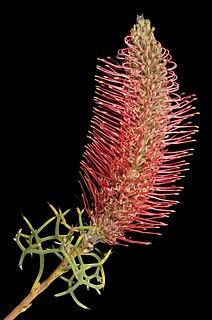
Banksia sessilis, commonly known as parrot bush, is a species of shrub or tree in the plant genus Banksia of the family Proteaceae. It had been known as Dryandra sessilis until 2007, when the genus Dryandra was sunk into Banksia. The Noongar peoples know the plant as budjan or butyak. Widespread throughout southwest Western Australia, it is found on sandy soils over laterite or limestone, often as an understorey plant in open forest, woodland or shrubland. Encountered as a shrub or small tree up to 6 m (20 ft) in height, it has prickly dark green leaves and dome-shaped cream-yellow flowerheads. Flowering from winter through to late spring, it provides a key source of food—both the nectar and the insects it attracts—for honeyeaters in the cooler months, and species diversity is reduced in areas where there is little or no parrot bush occurring. Several species of honeyeater, some species of native bee, and the European honey bee seek out and consume the nectar, while the long-billed black cockatoo and Australian ringneck eat the seed. The life cycle of Banksia sessilis is adapted to regular bushfires. Killed by fire and regenerating by seed afterwards, each shrub generally produces many flowerheads and a massive amount of seed. It can recolonise disturbed areas, and may grow in thickets.

Banksia sessilis var. cordata is a variety of Banksia sessilis, with unusually large leaves and flower heads. It is a rare variety that is restricted to the extreme south-west corner of Western Australia.

Banksia sessilis var. cygnorum is a variety of Banksia sessilis.
Banksia sessilis var. flabellifolia is a variety of Banksia sessilis.
Grevillea pteridifolia is a species of Grevillea native to Australia. Common names include silky grevillea, Darwin silky oak, ferny-leaved silky oak, fern-leaved grevillea, golden grevillea, golden tree and golden parrot tree. It occurs in Western Australia, Northern Territory, and Queensland.

Petrophile sessilis, known as conesticks, is a species of flowering plant in the family Proteaceae and is endemic to New South Wales. It is an erect shrub with rigid, needle-shaped, divided, sharply-pointed leaves, and oval, spike-like heads of silky-hairy, creamy-yellow flowers.

Grevillea sessilis is a shrub which is endemic to Queensland in Australia.

Micromyrtus sessilis is a plant in the myrtle family, Myrtaceae and is endemic to eastern Australia. It is a dense, spreading shrub with small, more or less linear leaves and flowers that are sometimes single in the upper leaf axils or in dense clusters along the branches. It is similar to M. ciliata but has a more northerly distribution.

Acacia sessilis is a shrub of the genus Acacia and the subgenus Phyllodineae that is endemic to south western Australia.

Grevillea paradoxa, commonly known as the bottlebrush grevillea, is a shrub of the genus Grevillea native to an area in the Mid West, Wheatbelt and Goldfields-Esperance regions of Western Australia.
Rinzia sessilis is a plant species of the family Myrtaceae endemic to Western Australia.
Enekbatus is a genus of shrubs in the family Myrtaceae described as a genus in 2010. Enekbatus are endemic to Western Australia.
Enekbatus bounites is a shrub endemic to Western Australia.
Enekbatus clavifolius is a shrub endemic to Western Australia.
Enekbatus cryptandroides is a shrub endemic to Western Australia.
Enekbatus cristatus is a shrub endemic to Western Australia.
Enekbatus dualis is a shrub endemic to Western Australia.
Enekbatus longistylus is a shrub endemic to Western Australia.
Enekbatus planifolius is a shrub endemic to Western Australia.
Enekbatus stowardii is a shrub endemic to Western Australia.






